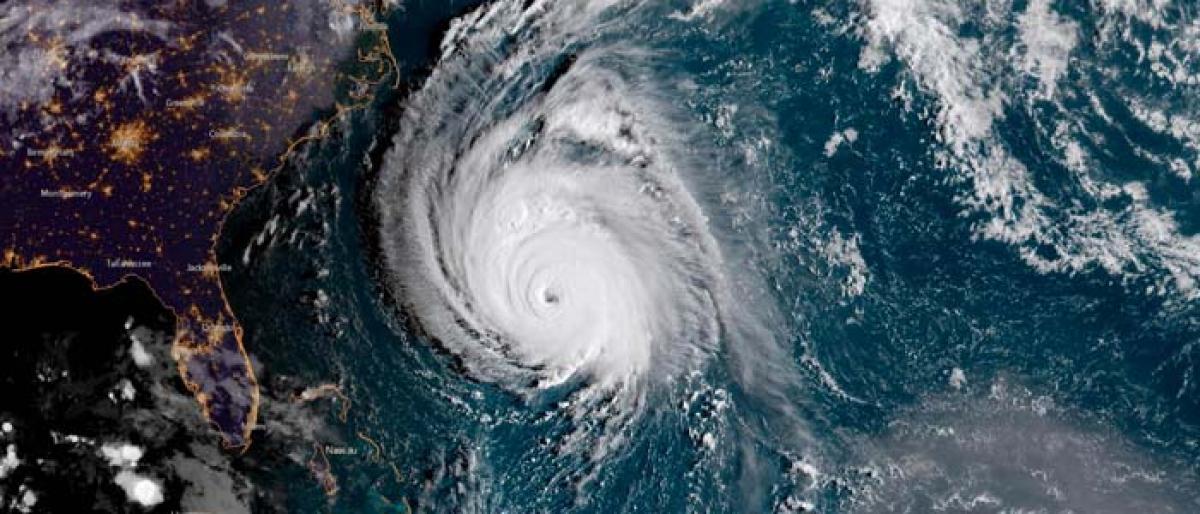Live
- Three killed in violence over mosque survey in UP’s Sambhal
- One killed, four injured in hand grenade explosion in southern Croatia
- IPL 2024 Auctions: Heartening to see almost every team showing interest in Yuzi, says childhood friend Piyush
- 15 killed, 20 injured in alleged paramilitary attack in Sudan
- Drugs valued at Rs 16 cr seized in Tripura
- Manipur violence: Assam Police mount 24x7 vigil along inter-state border
- The Impact of Wellness Programs on Employee Engagement and Retention
- IS claims responsibility for deadly attack in Afghanistan
- The Future of MSMEs: Embracing Innovation and Sustainability for Growth
- Army chief returns from Nepal after defence cooperation talks
Just In

Hurricane Florence, weakened but still dangerous, crashed into the Carolinas on Friday as a giant, slowmoving storm that stranded residents with floodwaters and swamped part of the town of New Bern at the beginning of what could be a dayslong deluge
Hurricane Florence, weakened but still dangerous, crashed into the Carolinas on Friday as a giant, slow-moving storm that stranded residents with floodwaters and swamped part of the town of New Bern at the beginning of what could be a days-long deluge.
The center of the hurricane’s eye came ashore at about 7:15 a.m. EDT (1115 GMT) near Wrightsville Beach close to Wilmington, North Carolina, with sustained winds of 90 miles per hour (150 kph), the National Hurricane Center (NHC) said.
North Carolina Governor Roy Cooper said Florence was set to cover almost all of the state in several feet of water.
As of Friday morning, Atlantic Beach, a town on North Carolina’s Outer Banks barrier island chain, already had received 30 inches (76 cm) of rain, the U.S. Geological Service said.
On the mainland in New Bern, authorities said more than 100 people had to be saved from floods and that the downtown area was underwater. The town’s public information officer, Colleen Roberts, told CNN 150 more people were awaiting rescue and that citizens were going out in their boats to help, despite blowing waters and swift currents.
“WE ARE COMING TO GET YOU,” New Bern city officials said on Twitter. “You may need to move up to the second story, or to your attic, but WE ARE COMING TO GET YOU.”
There were no immediate reports of storm-related deaths or serious injuries but more than 60 people, including many children and pets, had to be evacuated from a hotel in Jacksonville, North Carolina, after strong winds caused parts of the roof to collapse, local officials said.
National Weather Service forecaster Brandon Locklear predicted Florence would drop up to eight months’ worth of rain in two or three days.
More than 440,000 homes and businesses were without power in North and South Carolina early on Friday, utility officials said. Utility companies said millions were expected to lose power and that restoring it could take weeks.
Florence had been a Category 3 hurricane with 120 mph winds on Thursday but dropped to Category 1 before coming ashore. But forecasters said its extreme size meant it could batter the U.S. East Coast with hurricane-force winds for nearly a full day.
It is expected to move across parts of southeastern North Carolina and eastern South Carolina on Friday and Saturday, then head north over the western Carolinas and central Appalachian Mountains early next week, the NHC said. Significant weakening is expected over the weekend.
About 10 million people could be affected by the storm and more than 1 million were ordered to evacuate the coasts of the Carolinas and Virginia.
Almost 20,000 people had taken refuge in 157 emergency shelters, Cooper said.
Emergency declarations were in force in Georgia, South and North Carolina, Virginia, Maryland and the District of Columbia.
Still, some residents ignored calls to evacuate.
“I had a lot of fear initially but I’m glad to be inside and safe,” said Zelda Allen, 74, a retired tax accountant from Hampstead, North Carolina, who was riding out the storm at Wilmington’s Hotel Ballast with her husband.
“I’m worried about what I might find when I go home, though,” she said.

© 2024 Hyderabad Media House Limited/The Hans India. All rights reserved. Powered by hocalwire.com







